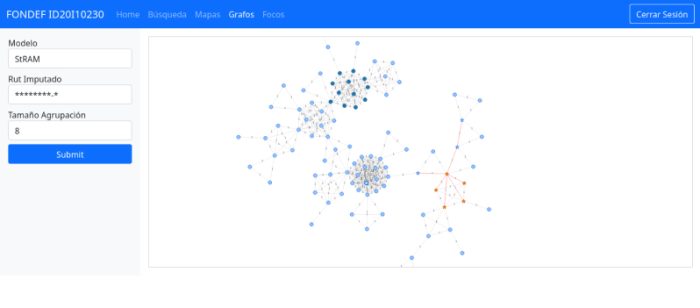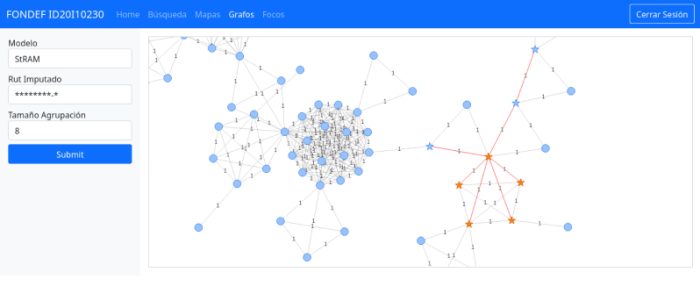Researchers from the Data Science group of the Complex Engineering Systems Institute (ISCI) developed an advanced analytics system that supports Chile’s Prosecutor’s Office through two models, expediting criminal analysis. The first reconstructs social networks and links between people with criminal records. The second uses Artificial Intelligence to identify patterns in the modus operandi in property crime cases. By cross-referencing the information, the system determines potential “people of interest”, reducing the complexity of the search for the service.
The system, known as FISCAL HEREDIA (an acronym from the Spanish term for a Tool for the Study of Crime using Artificial Intelligence) was developed within the framework of a FONDEF project. This is fed by large volumes of data obtained from the bases of the Prosecutor’s Support System (SAF) and the SOSAFE citizen security application. The institutions associated with the project hope that it will be adapted to other types of crimes, such as homicides and fraud.
Context
With the rapid advancement of Artificial Intelligence (AI), opportunities are opening up for new developments that impact society. One ISCI researcher participating in this process is Richard Weber, who has been working for more than five years in data science applied to written text processing, one of the branches of AI.
Based on developments that identified fraudulent car insurance claims and models that sought to prevent car theft, the researcher and his team acquired unique experience in the development of mathematical algorithms that recognize crime patterns of various types from natural language texts.
With the support of ISCI, in 2020 the researcher was awarded the FONDEF project “Integrated information analytics system for the prosecution of property crimes: Artificial Intelligence to detect criminal structures” in collaboration with Chile’s Coordinating Unit for Criminal Analysis and Investigation (SACFI) of the National Prosecutor’s Office and the company SOSAFE. The project also included the participation of academics from the Universities of Los Andes, Bío-Bío and the Faculty of Economics and Business (FEN) of the Universidad de Chile.
Innovative mathematical models to support criminal investigation
To develop the project, both the Prosecutor’s Support System (SAF) and the citizen security application SOSAFE made their databases available to researchers, while complying with privacy protection standards.
ISCI researchers Sebastián Maldonado and Carla Vairetti used SOSAFE data to identify patterns through the analysis of alerts sent by residents via the application. The objectives in this case were multiple. On the one hand, models were developed to enrich the information available in the Prosecutor’s Office for criminal prosecution. For example, thefts committed using vehicles with the same license plate or similar characteristics reported by users of the application were associated, identifying “crime drives”.
On the other hand, predictive models of home burglaries were conducted in different areas for better management of neighborhood security, making for a more effective preventive patrol. Finally, improvements were implemented in the organization of alerts sent through the application and received by police and municipalities, providing a better prioritization of urgent events requiring a quick response.
Two other aspects of the FONDEF project were developed based on data from the Prosecutor’s Office in cases of organized crime against property, which includes carjacking and home invasions, among others. Although its bases were anonymized to protect people’s identities, it does contain the data of the accused relating to the last 15 years, detailing crimes committed as well as unsolved cases.
From this information, the researcher and his team designed a mathematical model that reconstructs the social network of an accused party, understood as a set of individuals who connect and relate to each other.


“In the same way social networks like Instagram or Tik Tok work, we set out to model the social network among criminals, based on data that was ‘sleeping’, so to speak, in the SAF database, because it was information from the past that was not necessarily being used in current research. Each person who committed a crime forms a node in the network, and two nodes connect if they committed at least one crime together at some point. As an example, when we are faced with a crime committed by several people with one criminal captured, we can run the model and it shows us their possible connections. The potential of this tool is enormous, since it allows us to identify suspects using very little information and consider them in the investigation,”
explains project leader Richard Weber.
The map of a suspect’s social network is complemented by a second model, which uses Artificial Intelligence tools to process the texts of the victim statements made to the police. These documents have the advantage of having a fixed structure, which makes it easier to identify those events in which criminals operate in a similar way.
How is relevant information extracted to link similar cases?
Researcher Richard Weber decided to use a tool similar to the engine behind ChatGPT, which currently has 175 billion connections and is successfully trying to model the human brain, getting closer to its full potential.
This tool has already been pre-trained and made available to users to generate different applications such as FISCAL HEREDIA.
Even when police statements are poorly written or contain spelling mistakes, HEREDIA is capable of understanding the story behind the witness testimony, almost as if it were a human reader. It even goes one step further, discriminating among the endless volumes of information all relevant “entities”, such as the time, place, and date of the crime. It also finds patterns in the management of violence (if criminals use firearms; they beat residents; they poison pets; etc.), and ultimately identifies patterns in the type of items stolen. It is this set of entities that determines a “modus operandi”.
“People tend to specialize in all walks of life, and criminal groups are no exception. What changes is their modus operandi. Some prefer to work in pairs, others in large groups. Some may specialize in the use of firearms, while others opt for blunt objects, but never with weapons. Our HEREDIA model operates as an assistant to the Prosecutor’s Office, since it can quickly review, around the clock, data from previous cases to detect similar ways of operating. It also cross-references this information with the social network data of the suspects or those accused of similar crimes, which in many cases have been under investigation for months, thus saving time and salvaging information that, for a human reader, would have gone unnoticed due to the sheer amount of data available,”
explains Richard Weber.
“Criminal analysis today faces various important challenges. On the one hand, there is an increasing amount of information available, which is disaggregated into different sources and organizations. At the same time, the internal information available to the Prosecutor’s Office is not organized adequately enough for quick analysis. The fields with fixed data are basic, forcing analysts to reconstruct data on the accused, the victims, and the characteristics of the crimes by reading and analyzing police reports. An additional challenge for the purposes of criminal prosecution is the high rate of unknown perpetrators and criminal gangs that are changing their way of operating, adapting to new technologies and political-social circumstances in the territories where they operate. Therefore, we urgently need more and better tools for analysis aimed at criminal prosecution. In this context, Artificial Intelligence is a tremendous contribution, to the extent that it helps to associate seemingly unstructured information, finding links and patterns that are difficult to identify at first glance,”
explains Claudio Ramírez, coordinator of SACFI.
Validation of the tool
In order to validate the tool, the group conducted various tests.
“It was quite impressive for us and for our counterparts to see the effectiveness of our model. Real cases were used, in which the model was given the data of a single accused person, and it was asked to find, for example, the other two who participated in the crime. They ran the model through the Prosecutor’s Office, and quickly identified three possible suspects, including two accused criminals who were on the run. This is not magic. The tool realized that there were many connections between the suspects but reaching that conclusion from a human point of view, no matter how systematic you are in your work, is difficult since when you’re working on more than 100,000 cases a year,”
reflects the researcher.
Models developed with Artificial Intelligence tools have a great advantage. They are capable of working day and night and handling large volumes of information, but they are not intelligent. Therefore, they do not replace the work of understanding the data and establishing strategies to address crime carried out by analysts at the Prosecutor’s Office.
The advanced analytics system was officially launched in the Prosecution Service in March 2023. One of its first successful real cases was the arrest of three carjackers aged between 15 and 22 who livestreamed their crimes on social media. During the trial in Santiago, the Prosecutor’s Office was able to link the subjects to eight other carjackings committed in recent months, and their possible participation in other criminal acts is being investigated, all thanks to the support of FISCAL HEREDIA.
Upcoming challenges
ISCI, together with SOSAFE and SACFI, is applying for a new FONDEF project with the aim of continuing to work on the maturation process of the technology they developed in the first project.
“We believe the model needs to be enriched with more available data. In the first instance, we would like to include information from the Gendarmerie. By entering the dates of the defendants’ sentences, the places where they were served, and the names of their cellmates, we can refine the social network model. Also, mathematically we could work on assigning a value to the sentences, determining how much a year in prison weighs, for example, and including it in the equation,”
says the data science expert.
Another key challenge is to scale and package the system so that FISCAL HEREDIA runs on a server or in the cloud, allowing access for every local branch of Prosecutor’s Office in the country, as well as institutions such as Carabineros.
Finally, given the effectiveness of its results, the Prosecutor’s Office has requested work on adaptations of the system for crimes such as homicides, fraud, kidnappings, and drug trafficking.


